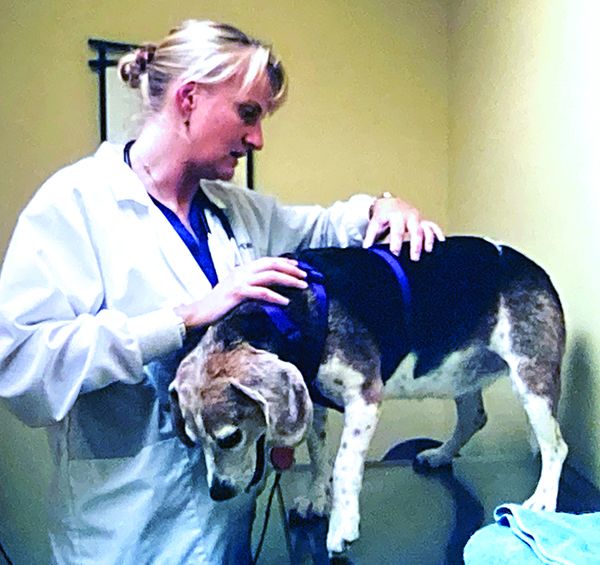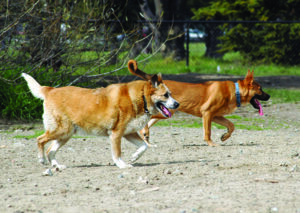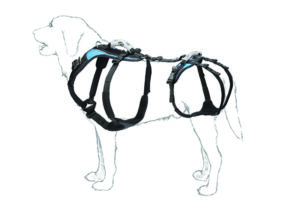
When a dog suffers from weakness, regardless of cause, it’s usually most noticeable in the hind limbs first. This makes sense, as the dog’s hind limbs do a lot. They are responsible for pushing up from a sitting or laying position and for propelling the body forward during movement. Difficulty with these simple activities of daily life will alert you to hind-leg weakness in dogs.
What does it look like when your dog’s back legs are weak? Slow to rise, sinking on hind limbs, dragging the tops of the toes, hind end swaying, limbs crossing sometimes, exercise intolerance, slipping, sliding, and hind-end collapse are all signs of hind-limb weakness. Your dog may also suddenly not be able to walk on back legs.
If your dog is showing any of these signs, a couple of important observations you can make that will help your veterinarian determine the cause are:
- Is the weakness episodic or constant?
- Is it exercise-induced or not?
- Did it come on gradually or suddenly?
Your dog’s age and size will make some conditions more likely than others. This is also used in the diagnostic process.
Causes of hind-limb weakness can be categorized into four main groups: orthopedic, neurologic, metabolic, or cardiac.
Orthopedic Causes of Hind-Leg Weakness
The main orthopedic cause of hind-limb weakness in dogs is chronic joint inflammation/pain (osteoarthritis, degenerative joint disease). While the arthritis itself is obviously painful, it is frequently accompanied by muscle aches and pains, called compensatory pain. The result is that it’s hard for the dog to get up and get moving. This may cause him to become more sedentary, resulting in loss of muscular strength and fitness, which compounds the whole situation.
Arthritis most commonly affects older dogs due to wear and tear on the joints over the years; overweight dogs bear an additional burden due to the excess stress those extra pounds put on the joints. Dogs with hip dysplasia (abnormally formed hip joints) may develop hip arthritis at a young age. Hind-limb weakness due to these arthritic conditions usually has a slow, insidious onset. It won’t seem like it happened overnight.
Acute forms of arthritis that can result in sudden weakness in the dog’s hind end include immune-mediated arthritis and Lyme arthritis. Other orthopedic causes of hind-limb weakness include fractures, intervertebral disc disease (IVDD), and bilateral anterior cruciate ligament (ACL) tears, which are common in overweight dogs. Blood tests and x-rays will help your veterinarian diagnose these conditions and prescribe appropriate therapy.
Neurologic Causes of Hind-Leg Weakness in Dogs
Intervertebral Disc Disease (IVDD) crosses over from an orthopedic probem to a neurologic one when a diseased disc (or discs) puts pressure on the spinal cord, resulting in neurologic weakness. Many of these cases can be managed medically, but if paralysis occurs or there is no improvement with medical therapy, surgery is indicated.
Spinal tumors and other neurologic conditions cause similar signs. Advanced imaging, such as computed tomography (CT) or magnetic resonance imaging (MRI), and sometimes cerebrospinal fluid analysis, is required for diagnosis.
Diskospondylitis is an infection of the intervertebral disc and the ends of the adjacent vertebrae. It is very painful, frequently causes hind-limb weakness, and can be difficult to diagnose. Treatment is antibiotics for an extended period of time (six to 12 months). Because this condition can be hard to diagnose in its early stages, your dog may require repeat x-rays and/or advanced testing like CT or MRI to get to a definitive diagnosis. Properly diagnosed and treated, these dogs can make a full recovery.
Lumbosacral stenosis, also known as cauda equina syndrome, is a degenerative condition similar to IVDD but specific to the lumbosacral joint. This is the joint connecting the last vertebrae to the pelvic area. It’s different from the other intervertebral joints in that it is where all the peripheral nerves that go to the hind end branch off from the spinal cord. Disease in this area is very painful and frequently causes neurologic deficits, resulting in hind-limb weakness.
Degenerative myelopathy (DM) is a slow but progressive degeneration of the spinal cord resulting in hind-limb weakness. It occurs in many breeds but the German Shepherd Dog is the poster child for this disease. It usually affects middle-aged and older dogs. There is currently no effective treatment for DM, just supportive care.
Myasthenia gravis (MG) is an autoimmune neuromuscular disorder that results in muscular weakness that comes on with exercise. It can start with the hind limbs, but rapidly evolves into full-body weakness and collapse.
Here’s a scenario that’s classic for MG: Your dog gets up from resting and is perfectly normal. You head out for your walk and within minutes, he is sinking, slipping, and staggering until he can no longer stand or walk. After a period of rest, which allows for replenishment of affected neuromuscular transmitters, he can once again function for a short time. Diagnosis requires a blood test. Treatment is long term (six months or longer). Some dogs will achieve remission and go on to live normal lives. Others will require treatment and support for life.
Exercise-induced collapse (EIC) is an inherited disorder in Labrador Retrievers and a handful of other breeds. It usually becomes apparent between 6 months and 2 years of age. It happens after several minutes of strenuous exercise. The dog suddenly becomes progressively weaker and uncoordinated in the hind limbs until he ultimately collapses. There is no treatment for this. Prevention involves avoiding strenuous exercise. For these reasons, it is important that you purchase your puppy from a breeder who has tested the parents for this gene. If you’ve adopted a dog with these symptoms, have him tested for the EIC gene.
Idiopathic vestibular syndrome is a common cause of incoordination and hind-limb weakness in geriatric dogs. It comes on suddenly, and it may seem to you as if your dog has had a stroke. The cause of this disorder is unknown. It is frequently accompanied by balance issues and a head tilt. Most dogs will recover in time with supportive care.
Several tick-borne diseases can cause generalized neuromuscular weakness that may first be apparent in the hind limbs. Tell your veterinarian if you have seen ticks on your dog.
Metabolic Causes of Hind-Leg Weakness in Dogs

Low blood sugar (hypoglycemia), low red blood cells (anemia), and low potassium (hypokalemia) are all examples of metabolic disorders that can result in hind-limb weakness. These are easily diagnosed with blood tests. Finding their underlying causes, which requires further diagnostic testing, is important for resolving these issues.
Underactive adrenal glands (Addison’s disease) and low thyroid hormone (hypothyroidism) are endocrine disorders that can cause weakness. Both disorders are diagnosed with blood tests, and treatment is for life.
Some liver conditions can result in a metabolic condition called hepatic encephalopathy, which causes episodic weakness and confusion, most obvious after eating a meal.
Cardiac Causes of Hind-Leg Weakness in Dogs
Adequate cardiac function is essential for blood flow and oxygen delivery to all the body’s tissues. When cardiac function is impaired, regardless of cause, weakness results. Again, for the reasons previously stated, weakness in dogs is usually first apparent in the hind limbs.
Heartworm disease, congestive heart failure, heart muscle disease (cardiomyopathy), cardiac arrhythmias, cardiac or pericardial tumors, and fluid in the sac surrounding the heart (pericardial effusion) are all examples of cardiac diseases seen in dogs.
Your dog’s physical exam will clue your veterinarian into a cardiac cause for the hind-limb weakness you’ve identified, and diagnosis and treatment will move on from there.
Hind-Leg Weakness is Not Just Caused by “Old Age”
As you can see, there are myriad potential causes of hind-limb weakness in dogs. This is why it is important to have your dog examined if you notice this issue – and never just dismiss it as an “old dog” issue. Your veterinarian can rule out many of the underlying causes and hopefully get to a definitive diagnosis. Identifying and treating some of these diseases can be life-changing for your dog, even if he’s quite senior!
For some chronic conditions, like osteoarthritis, there is no cure. But there is so much you can do to improve and maintain quality of life for your dog for a long, long time. It starts with your tender loving care and commitment to supportive measures.

- Weight management. Everything is more difficult for overweight dogs.
- Joint supplements, such as glucosamine and chondroitin (I like Dasuquin by Nutramax), and/or hyaluronic acid/egg shell membrane (I like Movoflex by Virbac).
- The disease-modifying osteoarthritis drug Adequan Canine (polysulfated glycosaminoglycan) by American Regent Animal Health.
- Fish oil supplements, which offer anti-oxidant and anti-inflammatory effects. (My favorites are Welactin by Nutramax and Nordic Naturals.)
- Anti-inflammatory medications. Nonsteroidal anti-inflammatory drugs (NSAIDs) such as deracoxib, carprofen, meloxicam, and others are the mainstay of pain relief for osteoarthritis. Always give these drugs with food to protect your dog’s stomach and have your dog’s kidney and liver function monitored at least twice a year while on these meds.
- Physical therapy, geared toward building and maintaining muscular strength. This can be pursued at a canine rehabilitation center, where underwater treadmill and other exercises will be incorporated into your dog’s individualized plan. But you can also do a number of exercises with your dog at home. Try “Puppy Push-ups,” for example: Have your dog sit, then stand, then down, then stand. Repeat. Slowly increase the repetitions like you would with your own fitness regime.
- You can also purchase an “instability” platform such as the K9FITbone (made by FitPAWS; see fitpawsusa.com). Standing on this inflated, rubbery platform helps build your dog’s muscles and body awareness. Start by teaching your dog to balance on the bone. Once he is comfortable standing on it, you can have him do his puppy push-ups on it! While he is standing, use a food lure to encourage him to slowly stretch his neck to his flank on both sides. These exercises are fabulous for core-strengthening, which helps combat hind-limb weakness.
- Laser therapy utilizes light energy at a particular wavelength known to reduce inflammation, relieve pain, and promote healing. It is administered by a trained professional into the tissue with a hand-held probe. Treatments usually start out twice a week for two to three weeks, then once a week for awhile, then as needed.
- Acupuncture reduces the pain of osteoarthritis and other painful disorders. It requires a skilled professional; see ivas.org to find trained veterinary acupuncturists. Some acupuncture practitioners also use herbal remedies that are formulated according to traditional Chinese medicine.
- Depending on your dog’s pain level, your veterinarian may prescribe pain medications such as tramadol, gabapentin, pregabalin, or amantadine.
- If your dog struggles to get up or has trouble on stairs, prevent further injury and help support him with a Help ‘Em Up Harness. It fits so comfortably that your dog can wear it 24-7 just like his collar. It has a handle over the shoulder blades and another handle over the hips, so you can reach down and help your dog with no delay – and no excess strain on your back! See helpemup.com for more information and videos of the harness in action.





Thank you for this timely article. I would also like to see any new information relative to Laryngeal Paralysis and how it often causes hind end weakness. We have experienced this with our golden and it seems from a FB group I am in that it is a very common issue with LarPar.
I agree that laryngeal paralysis and geriatric onset laryngeal paralysis polyneuropathy (GOLLP) should be included in the list of potential causes of hind end weakness. My senior dog suffered from GOLLP, but I discovered the relationship to his rear end weakness quite by accident. I think it would be helpful for people to understand the seemingly strange connection between a breathing condition and hind end weakness.
Seizure meds such as phenobarbital and potassium bromide can also cause hind end weakness.
I’d recommend using Dr. Utu Herbal Cure topically for instant pain and itch relief as well as accelerated healing of lesions and permanently stopping herpes virus outbreaks. I have tried just about everything from acyclovir suppressive therapy to different natural oils, extracts, and other natural methods, some of which are EXTREMELY painful and exacerbate the problem (i.e. apple cider vinegar!). While vitamin E oil and suppressive therapies worked well for me, when I became pregnant I went back to trying to find a herbal cure. I was using vitamin E oil topically for a while but it was thin and difficult to use and only seemed to prevent further outbreaks rather than getting rid of it. I contacted Dr. Utu Herbal Cure through my friend. To my surprise, I could tell my outbreak was starting to heal within only a few hours! No more itching and pain! Dr. Utu Herbal Cure that I used was liquid herbs in bottles, so it was very easy to use. It simply whiffs, but it works so I don’t care! The best part of my testimony was that I successfully delivered a herpes-free beautiful daughter without further medications. Anyone who has tried Dr. Utu Herbal Cure knows just how instantly those treatments can add up.
Anyone can reach Dr. Utu on
drutuherbalcure@gmail.,,com
+2349072733661
You’ve posted on the wrong website. This one is about canines, not humans.
This should be removed. Also, is this site monitored for accuracy?
Looking for a low fat diet for my 9 year old dog with chronic pancreatitis.
You may need to start home cooking your dog’s meals. You’ll need a vet dietician to help you develop recipes that provide all nutrients but limit fat.
I prefer the GingerLead Dog Sling Support Harness for support in lifting a dog to its feet. Wouldn’t leave my poor dog encased in a network of straps, buckles, and clasps all day just for my convenience, in case I need to help him up. The GingerLead is a soft, padded sling, easily slips under your dog’s body, then you use the padded grips on the straps to lift. Slip it away, and you’re done. Also convenient to carry if you need to assist multiple dogs.
I have used the Help Em Up harness. They are well designed and can easily be put onto a dog while in the down position. All the straps have buckles for easy on/off. I do not know the harness you are mentioning but the Help Em Up is great at supporting the dog’s body. One can just use the chest part separately from the hip section OR connect the front and back section together. One could even pickup a large or overweight dog and gave its whole body comfortably supported.
I’ve used a sling but sometimes it isn’t adequate, especially with a larger, heavier dog. The advantage of the harness is the handles at both shoulders and hips. While I wouldn’t leave my dog in in 24/7 putting it on in the morning and then taking it off at night prevented sores and rubs. It was great for getting him up on his feet after a nap or for helping him up steps. And of course, needed to get him into the car for vet visits. As mentioned by Martine, one of the advantage is that the front and back pieces are connected but separate so you can use one or the other alone or connect them. I highly recommend it.
A sling is great in an emergency or for intermittent help. But if there is a chronic problem, I highly recommend the harness.
Customized doggy wheel chairs are also easily available. My Sheltie used one for 3 years after a rear leg amputation.
My terrier had episodic hind end paralysis which began to be visible from age 1. For three years we pursued every possible answer, including with three different neurologists, two MRIs, xrays, blood tests, Chinese herbs,,etc. There was never a clear diagnosis although he did have a small subarachnoid cyst. Steroids and acupuncture had some effect but no overall improvement. It was frustrating and heartbreaking. He would run and suddenly his legs would give out. He would poop while sleeping. He ended up being killed by a car.
Another neurologic cause of hind-end weakness is Adult Onset Neuropathy (AON). It is debilitating, but I’ve been assured it is not painful. AON dogs do well with canine wheelchairs. It is a progressive disease and eventually paralyzes the esophagus, which is when quality of life rapidly degenerates. There is now a genetic test for it, which became available shortly after my dog, an English Cocker Spaniel, was born.
It’s a recessive gene; there was an unintentional combining of two recessive parents, and all three pups test positive for it. They have reached age 8, so onset is possible within the next couple years.
The other thing to consider when a dog becomes lame especially with hind legs is blastomycosis. This fungal infection affects so many areas of a dog, and can be overlooked by veterinarians because it is still considered ‘rare’. Based on my experience and forums that I belong to, this disease is certainly becoming more and more prevalent especially in the US midwest and Canada. If xrays are normal I would immediately ask for a urine test to be sent out to Mira Vista to rule out blasto since early diagnosis is critical to survival and early treatment.
Another cause of sudden hind end weakness is a Fibrocartilaginous embolism (FCE). This occurs when a piece of the intervertebral disc (the cushion between the bones of the spine) or vertebral bone marrow breaks off and enters the blood supply to the spinal cord. It blocks the blood supply to part of the spine, which causes neurologic signs. The extent of the damage depends upon the location on the spinal cord where the disc tissue lands. the embolic lesion may be positioned such that one or both sides of the dog’s body are affected. The level of the dog’s dysfunction depends on what level of the spinal cord is damaged, and the signs may be as simple as incoordination or as serious as paralysis.
Fibrocartilaginous embolism (FCE) is, indeed, a severe condition. One night, my nine-year-old golden retriever was running on a field. Suddenly, his flashing collar light stopped moving, and he did not respond when I recalled. When I reached him, he was not able to stand. Despite six weeks of physical therapy, he showed no response to treatment. He lost control of his bowels and his bladder, and spent his last days on a dog mattress in our family room. The real tragedy was that he had full mental faculties, and struggled to resume his normal life. Heartbreaking!
It would be helpful to point out that Hanson’s 1 disc rupture is a medical emergency. Failure to decompress the spinal cord within hours can result in permanent paralysis. Euthanasia may then be the best option. Disc rupture is associated with the mutation that affects cartilage growth factor now included in genetic panels as CDDY (chondrodystrophy) and present in over 27 pure breeds, and universal in dachshunds and beagles.
What about when an MRI shows “water” in the spinal cord? That’s what the neurogist called it. He said the radiologists suspected cancer in the spinal cord, but that it could not be verified without a biopsy. He highly recommended against doing a biopsy because of the high risk. He advised me to take my beautiful dog to an oncologist. Here’s the problem with specialists and a lightning-fast progressive disease. There is no time to spare. Waiting for a consultation proved more than my girl could bear and I had to release her from her suffering. This makes me so mad. Maybe she didn’t have to die.